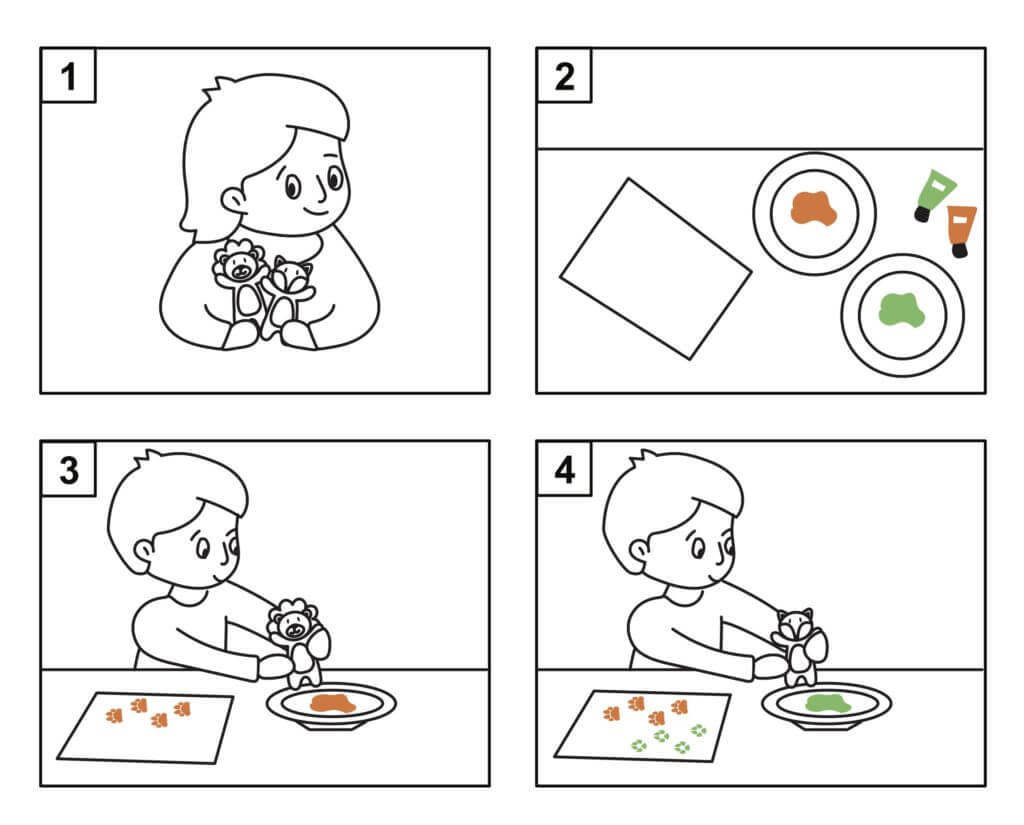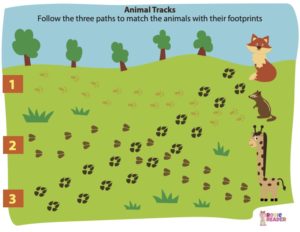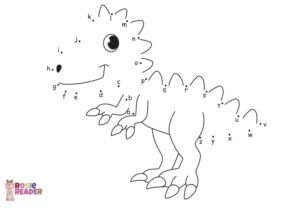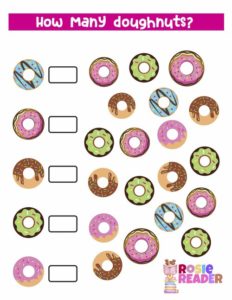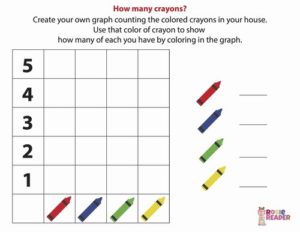Grab your favorite plastic animals and get ready to learn how to make animal tracks with your toys!
For this activity you’ll need a grown up and some washable paint or play dough. This is one of those unique animal tracks activities for preschool that is sure to delight kids and parents. Inspired by the book Life-Sized Animal Tracks by John Townsend, this animal tracks lesson is entirely play-based and led by your child using our child-friendly illustrated instructions.
The idea behind this preschool activity is to learn how different animals (toys) make different tracks. It doesn’t matter if the tracks aren’t an accurate representation. The bigger idea is to show that the footprints are different and correspond with each animal toy. Creating a path, whether by dipping plastic animal feet in paint or pushing plastic animal feet into play dough, allows kids to chart their own course, make their own path, and instills a sense of adventure.
Following the step-by-step written instructions you’ll find talking points to the animal tracks children’s book that inspired the activity but this activity in itself opens the doors to many conversations.
Ask your child to make up a story and introduce the 5W and H of storytelling:
WHO is going somewhere?
WHERE is the animal going?
WHAT will the animal find once there?
WHY is the animal going there?
WHEN is the animal going there?
HOW will the animal get there? (what path, etc.)
Here are the four steps illustrated above:
-
Grab at least two plastic animals. PLASTIC is important, as we don’t want stuffed animals damaged by paint or play dough. If you have a farm toy, it likely came with a few plastic animals. If you don’t have animals, look for something else that’s plastic. It can be a plastic doll or even a plastic block; basically anything plastic that can make an imprint.
-
Find a sheet of paper and two colors of washable paint. If you don’t have washable paint, do you have watercolors? Maybe you have play dough or kinetic sand? Find a substance that will allow your child to make an imprint with his or her toys.
-
To start, dip the feet of one plastic animal into one color of washable paint, then make footprints and create an animal track across your paper.
-
Repeat with your other plastic animal using a different color of washable paint.
TALKING POINTS FOR LIFE-SIZED ANIMAL TRACKS BOOK:
- What was your favorite animal print in Life-Sized Animal Tracks?
- Was your foot bigger than any of the animal prints? If yes, which one?
- Did any part of the animal footprints book surprise you?
- What do you call many lizards together? (Answer: a lounge of lizards)
- What is a hind foot?
- Do you have hind feet?
- Name two animals that have hind feet?
- Is there anything in this book that you didn’t understand?
- Is there anything specific about this animal tracks book you’d like to talk about?
USEFUL INFO FOR GROWNUPS
- Book: Life-Sized Animal Tracks
- Written by: John Townsend
- Edited by: Jacqueline Ford
- Designed by: Isobel Lundie
- Wildlife Consultant: John Rhyder
- Age Range: 7 to 9
- Illustrated edition: 48 pages
- Publisher: Book House (February 6, 2018)
- ISBN-13 : 978-1912006106
Want more animal tracks activities for preschool?
Match Animal Footprints – Draw a line from the animal and its sample footprint to its other animal footprint!
Animal Tracks Activity – Look closely at the ground to help match each animal with its footprints so they can reach the other side!
Check out this dot to dot alligator foot – Connect the dots to draw a true-to-size alligator foot. Then trace your foot in the space beside it. Is your foot bigger than an alligator’s foot?
MAKE A FLAMINGO HANDPRINT – Did you know you can use your hand to make prints too? Here’s an easy craft for preschoolers that goes step by step on how to use your hand to make a flamingo! I hope it was super fun to learn how to make animal tracks with your toys! I’d love for you to share your animal tracks with me on Facebook!
